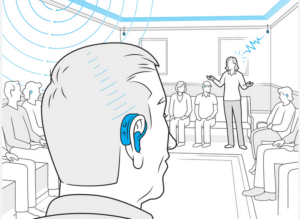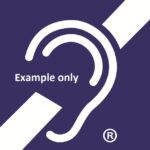As hearing aids technology continues to develop, there has been debate about what is “the best” form of wireless connection in public venues for hearing augmentation.
On the one hand, there are hearing loops and on the other Bluetooth. Let’s understand more about their differences and the pros and cons.
A hearing aid with a telecoil, also known as a T-coil or T-switch, is designed to work with hearing loop systems (Audio Frequency Induction Loops or just ‘loops’ for short), which are installed in theatres, auditoriums, railway and bus stations, places of worship, and other public spaces. The system uses a wire loop that generates a magnetic field, which is picked up by the telecoil in the hearing aid. This allows the wearer to receive audio signals wirelessly from the sound source that is connected to the hearing loop system, such as a microphone or sound system.

Bluetooth technology does not directly connect hearing aids with hearing loops.
Not all hearing aids are equipped with Bluetooth capabilities, and not all Bluetooth-enabled devices are compatible with all hearing aids. Telecoils and hearing loops, on the other hand, are widely supported in many hearing aids, making them a reliable and consistent option for hearing assistance in various settings. Every major brand of hearing aids has models with the telecoil.
Hearing loops are generally preferred as they require no self-disclosure on the part of the hearing aid wearer; no request for a ‘device’ which must then be worn; and no ongoing management in terms of charging and cleaning by venue managers.
While there are always situations where Bluetooth and other solutions may be preferred it’s not necessarily a preferred technology, more a best fit for a particular use case.
A relatively new Bluetooth protocol – Bluetooth LE – will work with Auracast transmitters but there are no known hearing aids fitted with working Bluetooth LE. Also, there are no Auracast transmitters on the market. It will be many years before all hearing aids are fitted with Bluetooth LE, and many more years before all hearing aids currently in use are replaced with hearing aids with Bluetooth LE.
The International Hearing Access Committee – members include the International Federation of Hard of Hearing People, the Hearing Loss Association of America and the European Federation of Hard of Hearing – says “The rights of hearing aid and cochlear implant users to access (hearing loops) must be continued and maintained during this period of technological change and shall not be compromised by the promise and overly optimistic expectations of a future technology development.”

The International Deafness Symbol shows that a hearing loop has been installed in a public place.
Under the Hearing Services Program, a hearing services provider is required to offer you a hearing device that has a telecoil in the first instance – a large number of the fully subsidised hearing devices have a telecoil fitted.
You can then choose a device without a telecoil if you wish. Your hearing clinic can talk to you about how to use the telecoil feature on your hearing device.
